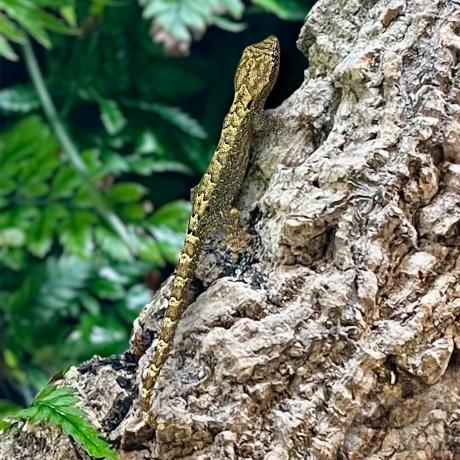

The Mourning Gecko is a small nocturnal species of gecko reaching no more than 10cm in total length. These are a very widespread species but the most interesting fact about them is that they are all female and breed via parthenogenesis!
Mourning geckos are a small gecko species only reaching 7-10cm length and average 10+ years old. The geckos are mainly light and dark brown in colour with wave-like, speckled patterning running along their back and down to their tail. This species can be housed together in communal groups without the need for sexing. “Why? Simple, they're all female! Mourning geckos are parthenogenetic meaning they do not need a male to reproduce. These geckos will lay fertile eggs and their offspring are little clones of themselves! They can communicate with various clicks, tail waving and back arches; each signalling threat, food, dominance, submission and much more.
Although Mourning geckos are known to be endemic to the Pacific region, such as Sri Lanka, the Maldives, Thailand, Malaysia, China, Vietnam, Fiji; they have also been introduced to Australia, Central and South America, the Galapagos, Costa Rica, the Seychelles, Mexico and the Hawaii islands. This species seem to adapt well to different environments however they are most commonly found living in communal groups around coastal rocky areas.
These sociable little geckos are arboreal (tree dwelling) the glass terrarium should have plenty of usable height. Even though they are small, we advise a minimum of 45 x 45 x 45cm (18in cube) as they will breed readily, meaning you will have space to house multiple geckos. Generations will usually peacefully cohabit and form a heirarchy, though it has been studied that very hungry adults can occasionally cannibalise hatchlings in order to survive. We do not advocate the mixing of species, and suggest keeping these in species specific enclosures to avoid any issues long term. Ensure there are no small gaps around the enclosure and care must be taken when opening glass doors as these geckos can easily squeeze through and escape!
The Mourning Gecko requires ambient temperatures of around 20-26°C during the daytime, with a basking area of 28°C. At night time, a temperature of between 5-10°C lower is recommended, to simulate the temperature drop which happens in the wild when the sun sets. A low wattage basking bulb can be used in a dome above the mesh, controlled by using a dimming thermostat, ensuring your geckos are maintained at the optimum temperature.
It is vital to provide these geckos with access to UVB lighting that sits within the parameters of Ferguson Zone 1 and should be on for 12 hours during the day and turned off at night. This helps them to produce vitamin D3 which is essential in the absorption of Calcium - keeping bones healthy and strong. Especially vital for a species which is essentially cloning itself to produce offspring. Good lighting will also trigger natural breeding behaviours, within the tank a hierarchy will be formed with the dominant females laying the eggs. They can occasionally stimulate each other by pseudocopulation which can trigger egg production in all involved participants!
These geckos are found towards the coast and their natural humidity levels will fluctuate; rising and falling between 50-90%. We recommend misting the decor, foliage and substrate both morning and evening. A shallow water dish can be added preferably up towards the top of the tank, but the geckos will tend to drink droplets of water from the foliage to stay hydrated.
For terrarium decor, the natural decor beautifully recreates a piece of the tropics. Adding in hollow cork tubes with foliage provides natural enrichment and offers the geckos plenty of climbing space and egg laying sites. Cork branches and vines also work well, adding to the natural look of any rainforest habitat. Artificial plants are ideal for adding plenty of coverage while keeping the setup fairly simple to maintain. It is worth noting however, that Mourning Geckos also do extremely well in live planted, bio-active tanks. Using a soil based substrate to cover the floor; adding a layer of leaf litter and moss on top of this can help to retain moisture levels.
Juveniles and adults can be fed on a high quality meal replacement powder diet, though by also providing the geckos with feeder insects, it offers enrichment by way of encouraging natural hunting and foraging behaviours - variety is key to having healthy, happy geckos.
On all live feeds, it is important to use a good quality supplement powder to provide an essential calcium and vitamin boost to your Mourning Gecko. The easiest method of application is to use a spare live food tub to dust the insects lightly in supplement. We advise dusting your insects on every feed, alternating between calcium and vitamin powders according to manufacturers recommendations.